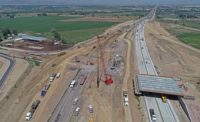It was around 2010 when a group of maintenance and snowplow drivers from the Idaho Transportation Dept. came to the agency’s director, Brian Ness, and other executives with a proposal to change winter scheduling. Rather than establish upfront the number of crews for specific times of the week, they would coordinate twice a week with the National Weather Service about predicted storms and change staffing accordingly. That would put more plows on the road only when they were needed, and workers could take days off at different times throughout the week.
“Before that change, we had about 28% of our roads clear of ice and snow during a storm. Now we are at about 86% to 97% because we have more people out there when we need them,” Ness says. “They could see the system that had been in place before was not very efficient, and they came up with a way to fix it.”
At the time, Ness had been ITD director for little more than a year. He came to the position in 2009 following a 30-year career with the DOT in his native Michigan. Now, Ness is one of the longest-serving state transportation directors in the country. His philosophy of empowering frontline employees and promoting solutions close to where work is being done has resonated in a state with vast amounts of open space and highway workers living in remote locations.
In addition to managing the roads in the Gem State, ITD oversees bicycle and pedestrian trails, the Dept. of Motor Vehicles, the Dept. of Aeronautics—with about 126 airfields and commercial airports—and bus and transit systems operated by municipalities.
“If it’s transportation in Idaho, it’s under us,” Ness says.
The department has approximately 1,600 employees and a current budget of $763 million, with $775 million funded for fiscal 2020-2021. The state is divided into six regions, each with a director appointed by the governor for a term of six years. The six directors and a chairman make up the board of directors, who oversee all operations.
Ness has led the streamlining of ITD, reducing administrative rules and getting the department to operate “more like a business,” he says. The director notes that the business law firm Stoel Rives LLP made an exception in its annual Innovation Awards several years ago when ITD was nominated as one of the innovative companies in the state.
“At first they told us we were nominated but couldn’t compete for the award because government regulates, and only companies innovate,” Ness says. “But after I told them some of the things we’d been doing and the innovations we’d made, they changed their minds. We were among the top three nominated for the award again last year.”
Dealing With Growth
According to the U.S. Census Bureau, Idaho has been the first- or second-fastest growing state, starting in 2015, and among the top 10 fastest-growing states since 2010. Dealing with that growth has been the key driver of change in the department, Ness says.
“When I came on in 2009, the focus had been, and still was, on preserving our existing system and protecting the investments made in previous decades,” he says. “We’ve done a good job of that. The condition of our highways has gone from 80% in fair to good condition in 2009 to 91% today, but we haven’t really been addressing growth. In recent years, we’ve shifted funds to address safety and capacity. We also know that over half of our bridges will be over 50 years old very soon, and we need to deal with that.”
While growth has been most evident in Boise and the surrounding areas of Meridian, Nampa and Eagle, Ness says those pressures have been felt across the state. Last year, ITD launched its largest current project, a multi-phase widening and improvement of nearly 15 miles of Interstate 84 from Nampa west of Boise to Caldwell. The $105.8-million project will widen the highway from two to three lanes in each direction, replace an overpass and create a new single-point urban interchange (SPUI).
“The condition of our highways has gone from 80% in fair to good condition in 2009 to 91% today, but we haven’t really been addressing growth.”
– Brian Ness, Director, Idaho Transportation Dept.
ITD built its first SPUI as part of an earlier congestion-relief project on I-84. Bryan Foote, manager of Idaho operations for Pleasant Grove, Utah-based Horrocks Engineers, says the department has shown a willingness to embrace new ideas. Foote says Horrocks is nearing completion of an environmental document and design for the next phase of the project, which will include the state’s first continuous-flow interchange.
“We proposed it as a possible solution for a particular part of the project and [ITD was] open to trying it,” Foote says. “ITD is great to work with. Their project managers are empowered to make decisions and keep the project moving.”
Mike Burke, CFO of Boise-based Concrete Placing Co., agrees. His firm has completed multiple paving and bridge projects for the agency over the years and is doing a significant portion of the work on the current I-84 project.
“[ITD] is straightforward and professional in dealing with contractors,” Burke says. “They are problem-solvers, and the management is very approachable. When we need something reviewed, it is usually easy to get a resident or staff engineer to work with, and they have the authority to make decisions.”
Alex Hall, a managing member and engineer at HMH Engineering, based in Coeur d’Alene, says the firm has worked on numerous projects for ITD. “It is really like a partnership. We work with everyone from maintenance to staff engineers to regional directors, and things get done quickly and efficiently without having to go through a lot of layers.”
Hall says HMH recently worked with ITD to connect two parts of a local Boy Scout camp with a pedestrian underpass below a state highway. “For a small project that seemed simple, we had almost every possible issue come up from funding and cost escalation to environmental concerns, wildlife and cultural resources and endangered species. But everyone really pulled together and dealt with things efficiently, and we got it done,”
Traditional Delivery
According to Blake Rindlisbacher, ITD chief engineer, the entire I-84 widening and improvement project is estimated at around $300 million to $350 million, most of which will be coming from grant anticipation revenue vehicle, or GARVEE, bonds as well as federal grants.
Like most road construction in the state, the project is being delivered using a traditional design-bid-build method. “We did one big design-build project a few years ago, and we’ve even done one CM-GC, but I think that could have been done design-bid-build,” Rindlisbacher says.
“We work pretty closely with our AGC [Associated General Contractors] and our ACEC [American Council of Engineering Companies] chapters, and their message back to us has been that they are comfortable with the design-bid-build process,” he says. “We know we are not the biggest fish in the pond. Most of our jobs are in the $10-, $20- and $30-million range and those lend themselves well to that traditional process.”
The design-build project completed in 2018 combined 17 bridge replacements in three districts into one package. Known as the 6-5-4 Project, for the districts where the projects were located, Rindlisbacher says the D-B method saved time as well as an estimated $4.7 million and won the AASHTO President’s Transportation Award in 2018.
Rindlisbacher says the agency also has had success with accelerated bridge construction in recent years. “We did our first ABC project up near Coeur d’Alene a few years ago and then again to replace and widen a bridge in Cloverdale near Boise. We learned a lot from those, and we are committed to doing more,” he says.
The Road Ahead
Rindlisbacher says ITD is changing its approach to funding and starting projects.
“What we want to do is have our program for that fiscal year advertised or under contract, so we are spending the money in the fiscal year it is available instead of stockpiling and spending it over time,” he says.
“Because of this new focus, our construction payouts have really gone up. The numbers are not as large as in some of our neighboring states, but for us, it is significant,” Rindlisbacher says. “For example, in 2016, before this change, we had $280 million in construction payouts. In 2019, we paid $452 million.”
Ness says another goal is training a new crop of leaders from within the organization to handle the coming wave of retirements.







Post a comment to this article
Report Abusive Comment